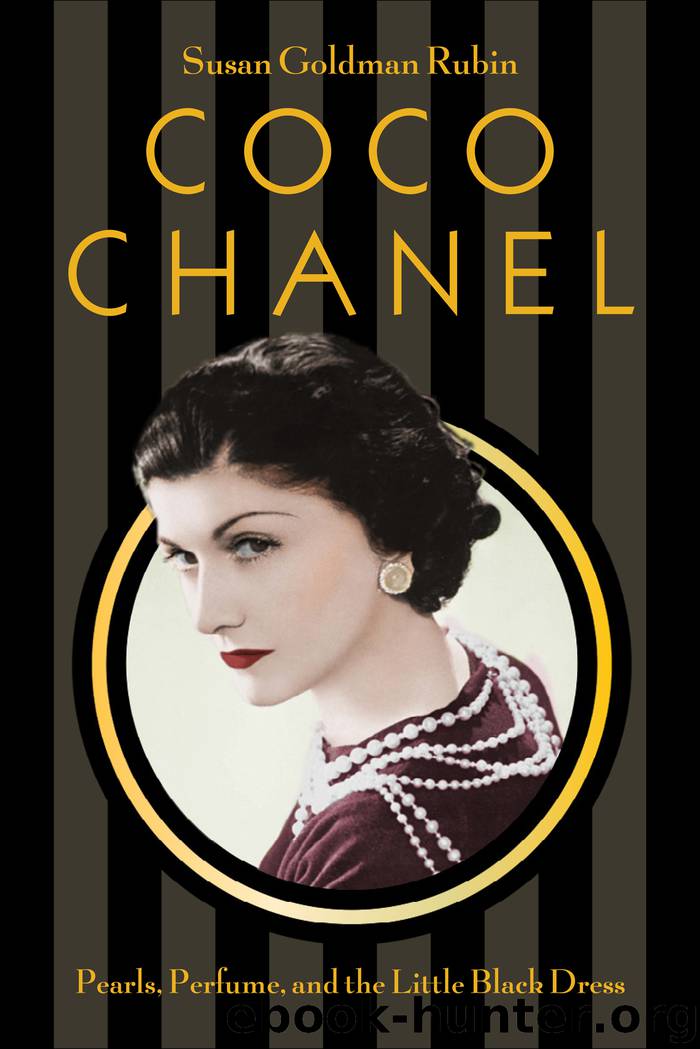Coco Chanel by Susan Goldman Rubin

Author:Susan Goldman Rubin
Language: eng
Format: epub
Publisher: Abrams
Published: 2018-03-22T04:00:00+00:00
Schiaparelli’s silk butterfly dress for evening, summer 1937
THAT ITALIAN
Schiap (pronounced skap), as she was called, came from a prosperous, intellectual, Italian family. In Paris she had risen to fame with her sporty separates (sweaters and skirts) and imaginative innovations. Schiap introduced a bold new color, shocking pink. She too was friends with Dalí and Cocteau and collaborated with them on zany surrealist designs: a gown printed with a life-size lobster, a hat shaped like an upside-down high-heeled pump. In 1935 Schiap opened her couture house on Place Vendôme, just down the street from the Ritz hotel. The Ritz was one of the most luxurious hotels in the world, with a superb dining room downstairs. Coco lived at the Ritz, and in the morning she left for work at her salon on rue Cambon, the street behind the hotel. So Schiap quipped, “Poor Chanel, I use the front door of the Ritz, she must use the back.”
Coco detested Schiap and bitterly referred to her as “that Italian who’s making clothes.”
Schiap called Coco “that dreary little bourgeoise” (a middle-class woman).
Coco thought that Schiap would soon be finished, with her outrageous styles. Yet in 1934 Time claimed that Coco was no longer the leader in fashion. Instead they wrote, “Mme. Schiaparelli is the one to whom the word ‘genius’ is applied most often.”
One evening the archrivals attended the same costume ball. The theme was an enchanted forest. Coco went dressed as herself, but Schiap disguised herself as a surrealist tree. “There was a near disaster,” recalled Bettina Ballard, the Paris editor for Vogue, “when Chanel . . . dared Schiaparelli . . . to dance with her, and, with purposeful innocence, steered her into the candles.” Schiap’s costume caught fire. “The fire was put out—and so was Schiaparelli—by delighted guests squirting her with soda water,” reported Ballard.
Schiap posed a serious threat to Coco throughout the ’30s. She built her collections around themes such as music and the circus. Celebrities, socialites, and royalty vied for front-row seats at her exciting runway shows.
Coco’s shows were “terribly sedate and a little bit dull,” wrote Danish journalist Ragna Fischer. Coco stayed hidden at the top of her famous mirrored staircase as the models glided down. But she won rave reviews for her sleek, elegant dresses.
Download
This site does not store any files on its server. We only index and link to content provided by other sites. Please contact the content providers to delete copyright contents if any and email us, we'll remove relevant links or contents immediately.
Adulting by Kelly Williams Brown(4488)
Pocahontas by Joseph Bruchac(4183)
Unfiltered by Lily Collins(3960)
In the Shadow of Liberty by Kenneth C. Davis(3336)
Earthrise by Edgar Mitchell(3010)
Almost Adulting by Arden Rose(2665)
Charlie and the Chocolate Factory (Puffin Modern Classics) by Roald Dahl(2387)
Borders by unknow(2231)
The Audition by Maddie Ziegler(2157)
Fierce by Aly Raisman(2157)
I Will Always Write Back by Martin Ganda(2107)
Women in Science by Rachel Ignotofsky(1665)
Amelia Earhart by Doris L. Rich(1650)
The Day the President Was Shot by Bill O'Reilly(1588)
The Last Days of Jesus by Bill O'Reilly(1545)
Redefining Realness by Janet Mock(1515)
God's Smuggler by Brother Andrew(1512)
Extraordinary, Ordinary People by Condoleezza Rice(1468)
Popular: Vintage Wisdom for a Modern Geek by Maya Van Wagenen(1428)
